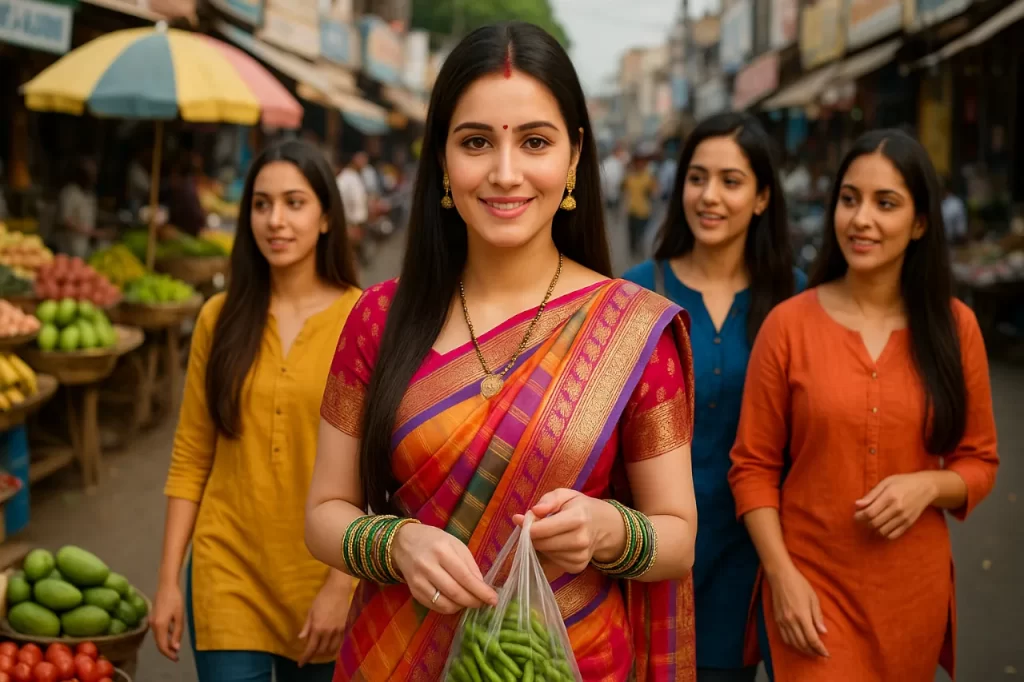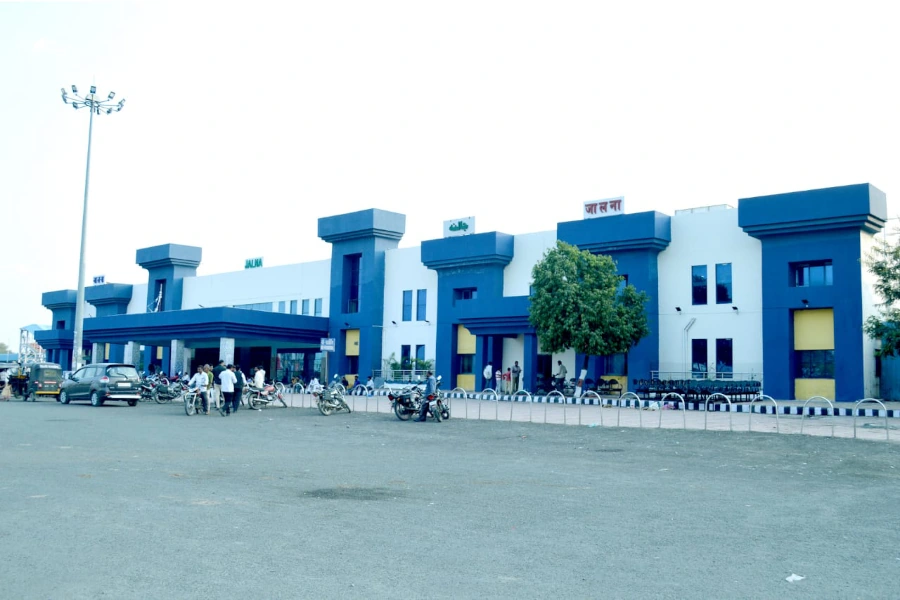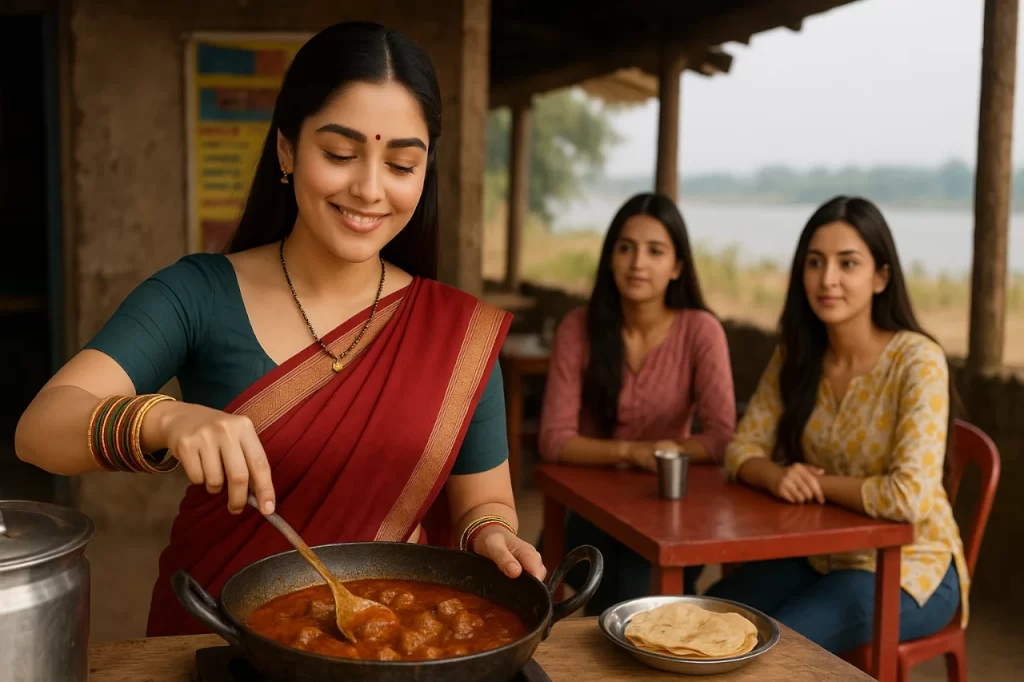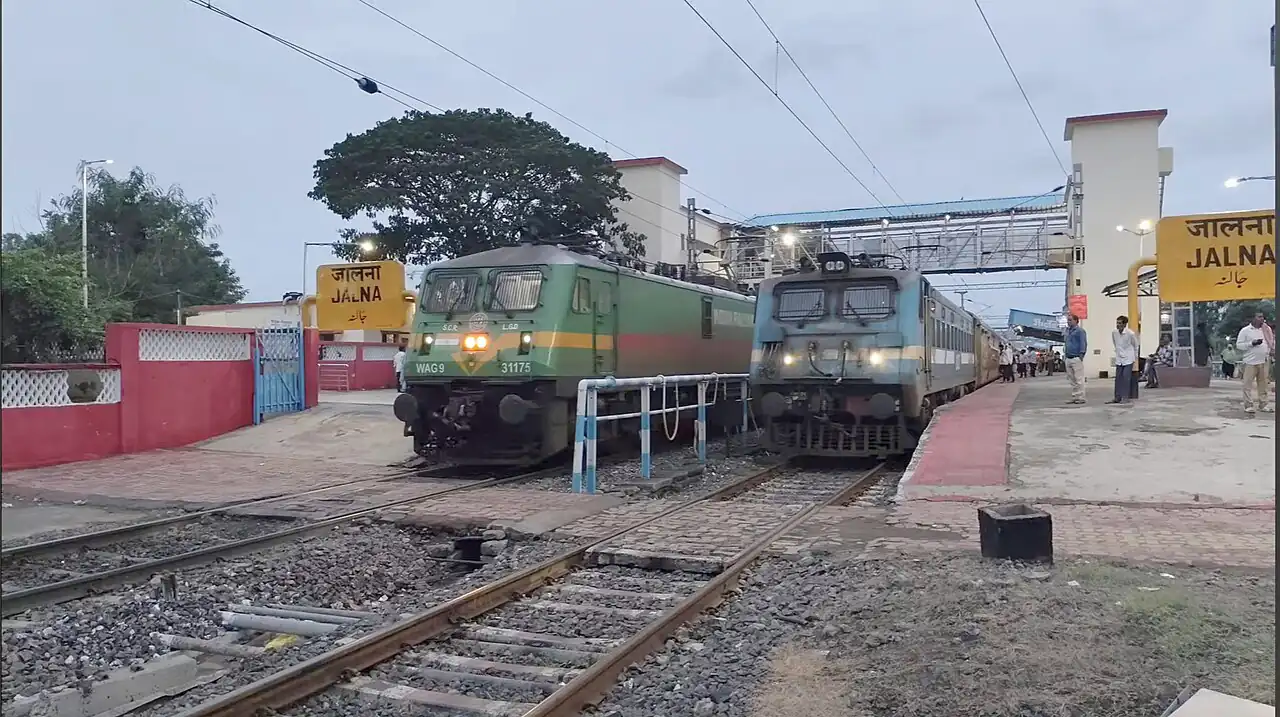Read on to uncover Jalna’s hidden gems!
“Where Ancient Forts Whisper Stories and Steel Towers Touch the Sky”
🔴 Introduction to Jalna: The Heart of Marathwada
Nestled in Maharashtra’s Marathwada region, Jalna is a city where history, agriculture, and industry converge. Once a strategic Mughal outpost, today it thrives as Maharashtra’s “City of Steel” and “Seed Capital”. This guide dives into Jalna’s layered past, architectural marvels, and bustling economy, offering travellers a roadmap to explore its unique charm.

🟢 Detailed Introduction to Jalna, Maharashtra, India
🔘 Geographical and Historical Significance
Jalna, a city in Maharashtra’s Marathwada region, is strategically positioned at 19.8410°N, 75.8864°E on the banks of the Kundalika River. With an elevation of 508 meters, it serves as the administrative headquarters of Jalna District, carved out of Aurangabad in 1981. Historically, it was part of the Nizam of Hyderabad’s dominion until its integration into India post the Marathwada Liberation Movement. It’s nickname, “City of Steel” and “Seed Capital of India”, reflects its industrial and agricultural prominence.
🔘 Early History and Naming
Originally known as Janakpur (linked to Lord Rama’s era), Jalna’s modern name derives from a 16th-century Muslim weaver-merchant, Jalal Khan, who renamed it Jalnapur. The city flourished under the Nizam Shahs of Ahmadnagar, with governor Jamshid Khan commissioning key infrastructure like the Kali Masjid (1557) and water reservoirs. The Mughals later fortified the region, constructing landmarks such as the Jalna Fort (Mastgad) in 1725 to counter Maratha invasions.

🔘 Mughal and Maratha Influence
Jalna’s fortifications expanded under Mughal emperor Aurangzeb and Nizam-ul-Mulk Asaf Jah. The city witnessed pivotal battles, including the 1803 Battle of Assaye, where British forces clashed with the Marathas. Post-independence, Jalna became a cultural and economic hub, blending its Mughal-era architecture with Maratha resilience.
🔘 Modern Governance and Infrastructure
Designated a district in 1981, Jalna now spans 7,612 sq. km, with eight talukas and a population of ~2.4 million (2025 estimate). The city’s infrastructure thrives with the Mumbai-Nagpur Expressway (Samruddhi Mahamarg) and a dry port in MIDC Phase 3, enhancing its logistics network.

🔘 Economic Powerhouses
Jalna is Maharashtra’s largest steel producer, housing MIDC industrial zones. It is also India’s hybrid seed pioneer, contributing to 40% of the nation’s Sweet Lime (Mosambi) production. The agricultural sector thrives with cotton ginning, oil pressing, and bidi manufacturing, rooted in 19th-century enterprises.
🔘 Cultural Tapestry
A melting pot of religions, Jalna’s population includes Hindus (60.73%), Muslims (27.34%), Buddhists (6.75%), and Jains. Festivals like Diwali, Ganesh Chaturthi, and Navratri are celebrated grandly, while local cuisine features Misal Pav, Puran Poli, and Kothimbir Vadi. Marathi is the dominant language, followed by Urdu and Hindi.

🔘 Demographic Overview
As of 2011, Jalna District had a population of 1.96 million, with 19.27% urban dwellers. The literacy rate is 71.52%, with a sex ratio of 937 females per 1,000 males. Child sex ratios remain a concern at 870 girls per 1,000 boys. The district’s rural areas (80.73% of the population) rely on agriculture, while urban zones focus on industry.
🔘 Climate and Environment
Jalna experiences a semi-arid climate with three distinct seasons:
☀️ Summer (March–June): Scorching temperatures (up to 43°C/109°F).
🌧️ Monsoon (June–September): Heavy rainfall (~750 mm), peaking in July.
☁️ Winter (November–February): Mild weather (12°C – 30°C), ideal for tourism.
➸ The city ranks 33rd in India’s National Clean Air Program.

🔘 Notable Personalities
➸ Samarth Ramdas Swami: 17th-century spiritual leader and author of Dasbodh, who established Hanuman temples across Maharashtra.
➸ Janardan Mama Nagapurkar: Freedom fighter martyred during the Marathwada Mukti Sangram.
➸ Dr. Badrinarayan Barwale: Founder of Mahyco Seeds, awarded the Padma Bhushan for revolutionising India’s agricultural sector.
➸ Arjun Khotkar: Former Maharashtra minister and prominent Shiv Sena leader.
Also Read
Unapdev Hot Springs, Shahada Taluka, Nandurbar District, Maharashtra
🔘 Modern Jalna: A Synthesis of Tradition and Progress
Today, Jalna balances its historical legacy with rapid industrialisation. The proposed Mumbai-Nagpur bullet train project and satellite monitoring facilities at Indewadi highlight its growing connectivity. Its vibrant markets, spiritual sites, and hybrid seed farms make it a microcosm of Maharashtra’s cultural and economic diversity.

🟣 Section Breakdown of the Article
👉 Historical Legacy: From Mughal forts to Maratha battles.
👉 Architectural Wonders: Temples, mosques, and colonial relics.
👉 Cultural Tapestry: Festivals, cuisine, and local crafts.
👉 Economic Powerhouse: Steel, seeds, and the dry port revolution.
👉 Travel Essentials: Distances from major cities, weather, and itineraries.
👉 FAQs: Quick answers for curious travellers.

Jalna: History, Culture, and Modern Progress
🟠 Detailed Section Breakdown
⭕ A Journey Through Time: Jalna’s Historical Roots
Jalna’s history dates to the 16th century under the Nizam Shahs of Ahmadnagar. Governor Jamshid Khan laid its foundations, building the iconic Kali Masjid and a network of reservoirs in 1557. The Mughals later fortified Jalna, with Emperor Aurangzeb commissioning the Jalna Fort (Mastgad) in 1725 to counter Maratha invasions. The city witnessed pivotal battles, like the 1803 Battle of Assaye, where British forces clashed with the Marathas. Post-independence, Jalna emerged as a district in 1981, carving its identity from Aurangabad and Parbhani.
⭕ Geography & Climate: Nature’s Bounty
Located at 19.8410°N, 75.8864°E, Jalna sits on the banks of the Kundalika River, with an elevation of 508 meters. Its semi-arid climate sees scorching summers (up to 43°C) and mild winters (12°C – 30°C). Monsoons (June–September) bring 650–750 mm rainfall, vital for its famed Sweet Lime (Mosambi) orchards.

⭕ Cultural Melting Pot
Jalna’s demographics reflect Maharashtra’s diversity: 60% Hindu, 27% Muslim, and smaller Buddhist, Jain, and Christian communities. Marathi dominates (76%), followed by Urdu and Hindi. Festivals like Makar Sankranti (Kite-flying) and Diwali light up the city, while street foods like Misal Pav and Puran Poli tantalise taste buds.
⭕ Economic Backbone
Jalna is Maharashtra’s steel hub, home to MIDC industrial zones. It’s also India’s hybrid seed pioneer, with Mahyco (founded by Padma Bhushan awardee Badrinarayan Barwale) leading agricultural innovation. The 2021 dry port project in MIDC Phase 3 positions Jalna as a logistics nexus.

⭕ Architectural Heritage
⦿ Jalna Fort: Persian-inscribed citadels and hidden wells.
⦿ Matsyodari Temple: A 10th-century shrine on a fish-shaped hill, hosting Navratri fairs.
⦿ Khandoba Temple: Built by Queen Ahilyabai Holkar, featuring triple spires.
⭕ Travel Guide: How to Reach Jalna, India
Comprehensive Travel Guide: Reaching Jalna and Distances from Major Indian Cities
⛔ Introduction to Jalna’s Connectivity
Jalna, a historically significant city in Maharashtra, is well-integrated into India’s transportation network despite its modest size. Located in the Marathwada region, it serves as an agricultural and industrial hub. The city lacks an airport but compensates with robust rail and road links. The nearest airport is Chikkalthana Airport (IXU) in Aurangabad (55 km away), while Jalna Railway Station (Station Code: J) and the central bus depot anchor its land connectivity. National Highway 753F and state highways facilitate smooth road access from neighbouring districts and metros.
⛔ Air Travel: Nearest Airports and Flight Options
The most practical air gateway to Jalna is Aurangabad Airport (IXU), 55–64 km away. It offers daily flights from key cities:
⦿ Delhi: IndiGo and AirIndia operate direct flights (1h 55m–2h, ₹4,800 – ₹6,000).
⦿ Mumbai: Frequent flights (1h 05m, ₹3,156 – ₹3,972) via IndiGo.
⦿ Hyderabad: Direct flights (1h 30m, ₹4,300 – ₹5,000).
From Aurangabad, Jalna is accessible by Taxi (1h 15m, ₹1,000 – ₹1,500) or Bus (1h 45m, ₹100 – ₹200).
Alternate airports include Nagpur (300 km) and Mumbai (325 km), though they require longer road journeys.
⛔ Rail Connectivity: Trains to Jalna
Jalna Railway Station (J) connects to major cities via Indian Railways:
➸ Mumbai: Direct trains like the Mumbai CSMT – Jalna Vande Bharat Express (20706), Devagiri Express (8h 13m, sleeper ₹150 – ₹200) and Tapovan Express (8h 45m).
➸ Delhi: The Jalna – New Delhi Express (24h 40m, sleeper ₹550 – ₹700; 3AC ₹1,600 – ₹2,400).
➸ Hyderabad: Daily trains (6–7h, ₹180 – ₹300) via the Hussain Sagar Express.
➸ Pune: Transfers via Aurangabad (train to Aurangabad: 49m, ₹11 – ₹75; then bus/taxi). Tickets can be booked via IRCTC.

⛔ Road Networks: Buses and Self-Drive
Jalna’s Central Bus Depot hosts state-run (MSRTC) and private operators:
⦿ Mumbai to Jalna: 395 km (8h 08m), fares ₹450 – ₹800 for AC buses.
⦿ Pune to Jalna: 250 km (5h 30m), buses every 30–60m (₹400 – ₹700).
⦿ Nagpur to Jalna: 325 km (6h 45m), luxury buses (₹650 – ₹1,000).
🚗 Self-drive routes:
⦿ From Mumbai: NH160 via Nashik (395 km, tolls ₹600 – ₹800).
⦿ From Hyderabad: NH65 via Nanded (300 km, 6h).
🕰️ Distance and Travel Time from Key Cities
➨ Distances from Major Cities (Table: Jalna’s Connectivity with Major Cities)
| City | Distance (km) | Travel Time (Rail) | Travel Time (Road) | Preferred Mode |
| Aurangabad | 60 km | 49 min (Train) | 1h 15m (Taxi) | Train/Taxi |
| Pune | 300 km | 8–9 hrs (Express) | 8–9 hrs (Bus) | Overnight Train/Bus |
| Nagpur | 405 km | 8 hrs (Express) | 6h 45m (Bus) | Bus |
| Mumbai | 406 km | 8–9 hrs (Express) | 8–9 hrs (Bus) | Overnight Train/Bus |
| Delhi | 1,270 km | 24h 40m (Direct) | 21 hrs 30 min (Drive) | Flight + Train |
Note: Distance is approximate and travel time may vary. Please check with google maps or local authorities before travelling.

⛔ Local Transport in Jalna
⦿ Auto-rickshaws: Ubiquitous for short distances (base fare: ₹30 for 1.5 km + ₹15/km thereafter).
⦿ Taxis: Ola and private operators available (₹15 – ₹20/km).
⦿ Buses: MSRTC city buses connect attractions like Jalna Fort and Siddheshwar Temple (fare: ₹10 – ₹25).
⛔ Seasonal Considerations
☁️ October – March (15°C – 30°C): Best for sightseeing [Optimal Travel Window].
🌧️ Monsoon (July – September): Heavy rains may disrupt Road/Rail schedules.
☀️ Summer (April – June): Avoid daytime travel (up to 42°C).
⛔ Booking Tips and Resources
⦿ Flights: Use Skyscanner or MakeMyTrip for Aurangabad flights.
⦿ Trains: IRCTC app for ticket bookings; prioritise express trains for efficiency.
⦿ Buses: redBus or Abhibus for MSRTC and private operators (e.g., Om Shri Sairam Travels).
⛔ City-Specific Route Recommendations
➸ From Delhi: Fastest = Flight to Aurangabad (1h 55m) + taxi (1h 15m, total 4h 40m, ₹5,400). Cheapest = Direct train (24h 40m, ₹640).
➸ From Mumbai: Convenient = Overnight bus (8h, ₹500) or Devagiri Express (8h 13m, ₹150 – ₹200).
➸ From Hyderabad: Efficient = Direct train (6–7h) or self-drive via NH65 (300 km, 6h).
⛔ Infrastructure and Practical Notes
➸ Highway Quality: NH753F and NH160 are well-maintained; expect minor delays near rural stretches.
➸ Rail Station: Jalna’s station has basic amenities (waiting rooms, food stalls). Pre-book cabs via Ola/GoaCabs.
➸ Bus Terminals: Kanhayya Nagar (Jalna) is the Primary hub; Private buses drop at Siddhivinayak Temple Junction.
For real-time schedules, consult IRCTC (Trains), redBus (Buses), or Skyscanner (Flights). Jalna’s blend of rail efficiency and road flexibility makes it accessible year-round, with October–March ensuring a comfortable exploration of its forts and temples.
⭕ Best Time to Visit: October–March for pleasant weather
➨ Top Attractions
➸ Jalna Fort: Winter mornings for guided tours.
➸ Jayakwadi Bird Sanctuary: Spot migratory birds (November–February).
➸ Padmasani Temple: Evening Aarti for spiritual solace.
➨ Local Markets
⦿ Jalna Bazaar: Handloom textiles and silver thread-work.
⦿ Ambad Market: Fresh Mosambi and Traditional Bhakri flour.
⭕ Best Places for Authentic Local Food
➸ Moti Bagh Street Stalls: Near Moti Talav, savour Jhunka Bhakar (Gram Flour Curry with Millet Bread) and Sabudana Khichdi during monsoon evenings.
➸ Ambad Market: Famous for fresh Mosambi (Sweet Lime) juice and Shev Bhaji (Fried Snacks with Spicy Gravy).
➸ Old Jalna Bazaar: Try Puran Poli (Sweet Flatbread) and Kanda Bhaji (Onion Fritters) at century-old stalls.
➸ Khandoba Temple Prasadam: Relish Pithla Bhakri (Spiced Chickpea Curry with Flatbread) offered as temple Prasad.

⭕ Top Places to Visit (Granular Details)
➸ Matsyodari Devi Temple: Perched on a fish-shaped hill, this 10th-century shrine hosts a grand Navratri fair. The hill’s unique geology and panoramic views attract pilgrims and trekkers alike.
➸ Jalna Fort (Mastgad): Built in 1725, this Mughal citadel features Persian inscriptions, hidden wells, and bastions. Winter mornings are ideal for exploring its quadrangular architecture.
➸ Kali Masjid: A 16th-century black-stone mosque with intricate carvings, reflecting Indo-Islamic craftsmanship.
➸ Sri Ganesh Temple (Rajur): A revered Pitha (Seat) of Lord Ganesha, known for Angarika Chaturthi celebrations.
⭕ Where to Stay
➸ MIDC Area Hotels: Budget-friendly options like Hotel Midtown cater to industrial travellers.
➸ Jalna City Centre: Mid-range hotels such as Hotel Amarpreet offer proximity to markets and temples.
➸ Aurangabad (55 km): Luxury stays like Lemon Tree Hotel provide easy access to Jalna via the Mumbai-Nagpur Expressway.
Note: Hotel rates are subject to change and may vary based on factors like seasonality, availability, and promotions. Taxes, service charges, and other applicable fees are not always included in displayed rates.
⭕ Detailed Demographics
⦿ Population: 1.96 million (2011), projected to reach 2.43 million by 2025.
⦿ Religions: Hindu (76.8%), Muslim (14%), Buddhist (7.79%).
⦿ Literacy: 71.52% (Male: 81.53%, Female: 60.95%).
⦿ Urban-Rural Split: 19.27% urban, 80.73% rural.

⭕ Climatic Conditions (Granular Details)
☀️ Summer (March–June): Average highs of 102°F (May), dry heat.
🌧️ Monsoon (June–September): 750 mm rainfall, humidity peaks in July.
☁️ Winter (November–February): Pleasant temperatures (57°F – 83°F), ideal for tourism.
⭕ Notable People
➸ Saif Tyabji: Educator and former MP, known for advocating rural education.
➸ Kailas Gorantyal: MLA and grassroots political leader.
➸ Moulai Nooruddin Saheb: Dawoodi Bohra community leader, buried in Jalna’s Mazar-e-Moula.
This comprehensive guide captures Jalna’s essence, from its historical roots to modern-day vibrancy, ensuring travellers and researchers gain a multifaceted understanding of this dynamic region.
➤ FAQs
What is Jalna famous for?
Steel Industries, Mosambi Orchards, and Historical Forts.
Which language is spoken in Jalna?
Primarily Marathi (76%), Urdu, and Hindi.
Are there wildlife sanctuaries near Jalna?
Yes, Jayakwadi Bird Sanctuary (50 km away).
➤ Conclusion
Jalna is a microcosm of Maharashtra’s heritage and progress. Whether you’re tracing Mughal inscriptions at Mastgad or savouring street food at Moti Bagh, the city offers a timeless journey. With its strategic location and growing infrastructure, Jalna invites travelers and investors alike to witness its renaissance.
➤ Sources:
⦿ Jalna District Official Website
⦿ Maharashtra Tourism Board – Jalna
Image Credit
⦿ Wikimedia Commons – Jalna Railway Station
⦿ Wikimedia Commons – Jalna in Maharashtra (India)
⦿ Wikimedia Commons – 101-Jalna.svg
⦿ Wikimedia Commons – Trains at Jalna station
For more information, you can visit our website: ExploreXP
Ready to explore Jalna? Share your travel plans in the comments below!
